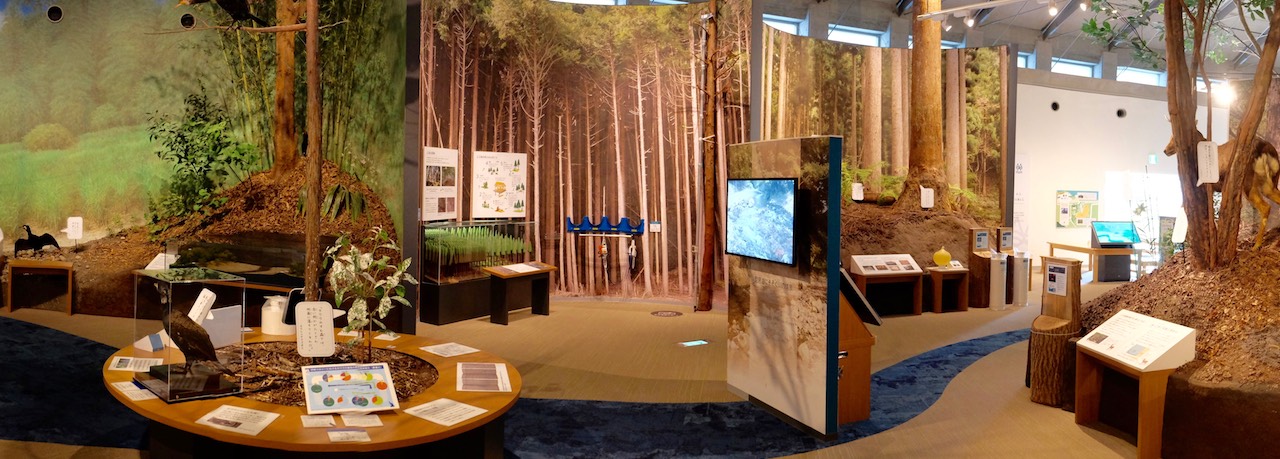
This exhibition room explores the relationship between the nature of the Lake Biwa watershed and people.
Starting with the lake and moving outwards through the reed beds to the rice paddies, rivers and forests, the environment, wildlife and the relationship between people and nature are examined. A comparison of lifestyles in the years between 1955 and 1965 with present lifestyles suggest possibilities for the future. You can also learn about the creatures that inhabit Shiga Prefecture by viewing specimens and videos. The curators' research, and field information provided by local people can also be accessed here.
Let's start our journey with a visit to the Lake Biwa watershed!
1. Let's Go to Lake Biwa
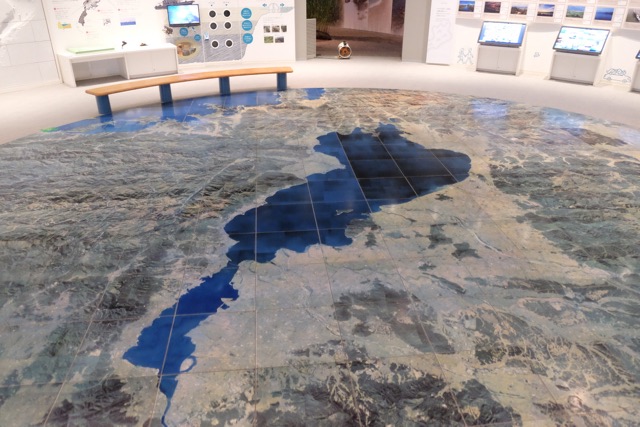
Let's Go to Lake Biwa
On the floor at the center of the circular room you can see a 6 m diameter aerial photo image of Lake Biwa and its surroundings at a scale of 1:10,000. Seven exhibits with different themes are displayed on the walls. They are, from the left of the entrance and moving in a clockwise direction, "Interesting Physical Phenomenon," "Introduction to Lake Biwa," "Geography and Environment of Lake Biwa," "Landscape Photo Album," "Human Modification to Lake Biwa and Its Surrounding Geography," "Lake Biwa Water Use" and "History of the Water Quality Issue."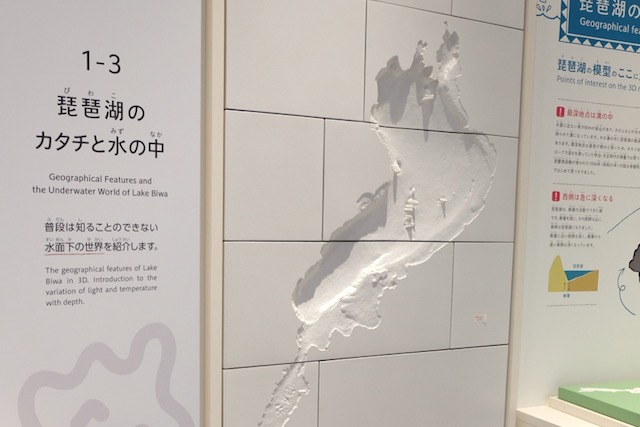
Geographical Features of Lake Biwa
This section introduces the underwater world of Lake Biwa which we don't usually see. A 3-D model displayed in this section shows the topography of the lake bottom. In order to show the features clearly, depth in the model is exaggerated by a factor of 25. The actual lake is much shallower than appears in this model. Lake Biwa, wide and deep at the north end and narrow and shallow in the south, looks like a short-necked Japanese lute called a biwa. It is believed that the name of the lake came from this musical instrument.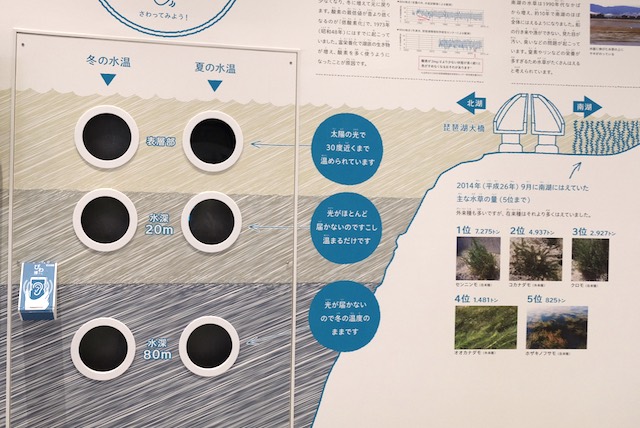
Let's explore the underwater world of Lake Biwa
This section introduces the underwater environment of Lake Biwa, particularly the light penetration and water temperature, which vary depending on the depth. Light can reach depths up to 30 m but areas deeper than this are completely dark. The temperature of the surface water where the sunlight penetrates is high in summer, but the deep areas remain cold throughout the year. You can feel the difference in the water temperature by touching the plates arranged in two columns of three. The left column shows water temperatures in winter and the right column shows water temperatures in summer. The three layers show the temperature at the lake surface, at a depth of 20 m, and at 80 m.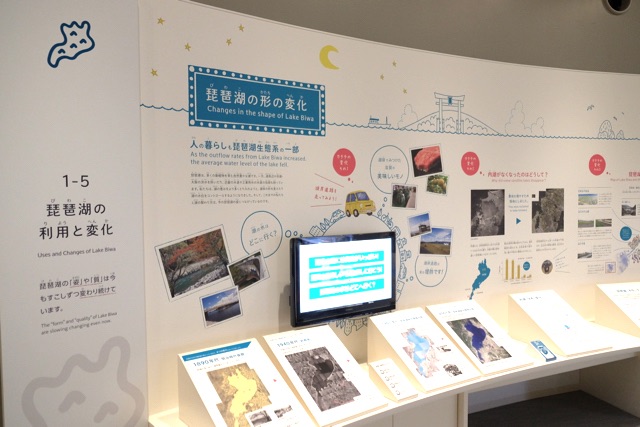
Changes in the shape of Lake Biwa
As our lifestyles have changed, the outline of Lake Biwa has changed. Water from Lake Biwa flows through Kyoto and Osaka via the Seta River, so the lake served as a natural dam to store water, protecting the prefectures downstream from flooding even before people modified the lake. Since the Meiji era, from 1868 to 1912, the water level of the lake has been controlled by dykes built along the lakeside. As a result, the dam function of the lake has been improved, greatly reducing floods and water shortages.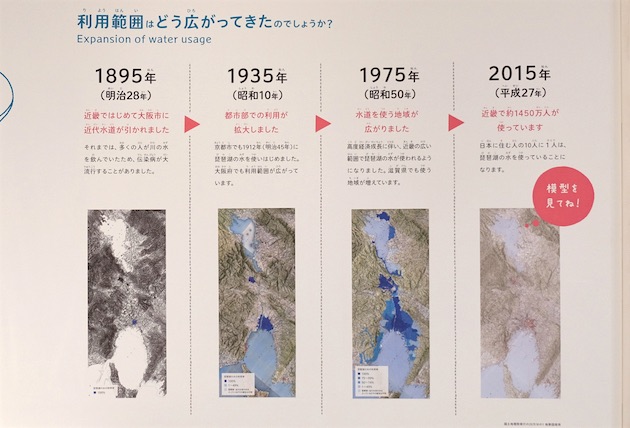
Water use of Lake Biwa
This section explains the extent to which Lake Biwa water is utilized in the Kinki region, and how the water is repeatedly used before it reaches Osaka Bay.The first water service in the Kinki region became available in Osaka City in 1895. In the following 120 years, the region that uses water from Lake Biwa and its outflowing river as tap water has steadily expanded. At present, one in ten residents in Japan uses water from Lake Biwa.
2. Into the Reed Marshes
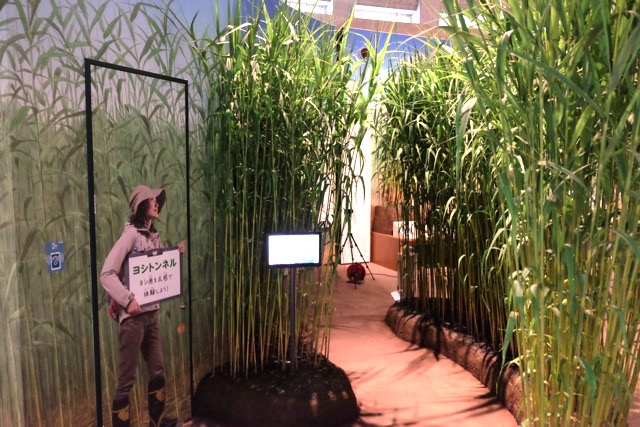
Into the Reed Marshes
Reed beds are one of the typical landscapes found around Lake Biwa. The reeds at Lake Biwa can grow 4 m high. They grow in water and on land. This section shows how reed beds change with the seasons, the kinds of creatures that can be observed in each season and how the reed beds are utilized by people.Here is an opportunity to think about the relationship between reed beds and people. Let's get to know a reed bed by entering the reed tunnel, a diorama that reproduces a reed bed in June.
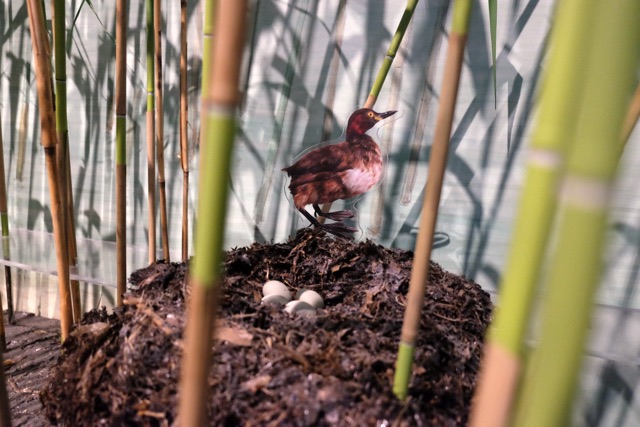
Reed Beds from Spring to Summer
Reed beds change their appearance with the seasons. In this section, dioramas reproduce reed beds in spring to summer, summer to fall, and in winter, and display the wildlife that populate each season.Reeds sprout in April and grow to about 3 m by June. A variety of creatures become active in the reed beds in spring to summer. In the water, fish such as ray-finned fish, gather among the reeds to spawn. On the water surface and upper part of reed stems, birds such as grebes and great reed warblers, build nests.
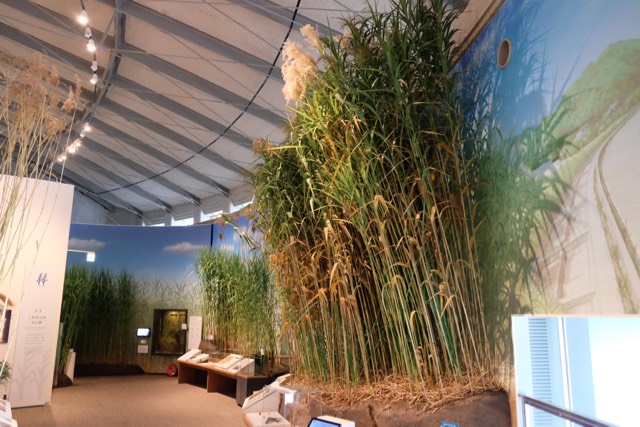
Reed Beds from Summer to Fall
In summer reeds grow as high as 4 m above the surface. They form ears and produce flowers in September. This section displays typical creatures found in reed beds from summer to fall. From left to right, notice a swallow, a tree frog and a harvest mouse. Please touch them to get a sense of their size. After making their first flight from the nest, swallows get together and fly to the reed beds to spend the night. Harvest mice weave nests from leaves in fall to raise their offspring.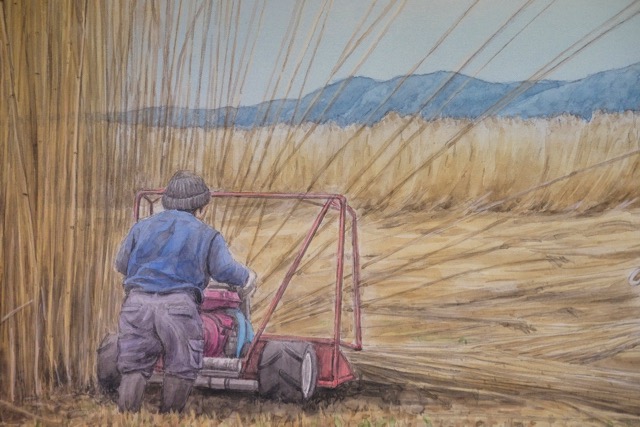
Relationship between People and Reeds - Reed Beds in Winter
This section shows reed beds in winter and the various ways people utilize reeds. When winter comes reeds wither and turn a yellowish color. Almost all leaves fall and only the stems remain standing. Even in this season a variety of creatures, such as raccoon dogs and birds, can be seen in the reed beds. Reeds are harvested from January to March and dried to be processed into many items. After harvesting, reed beds are burned in preparation for the next sprouting.
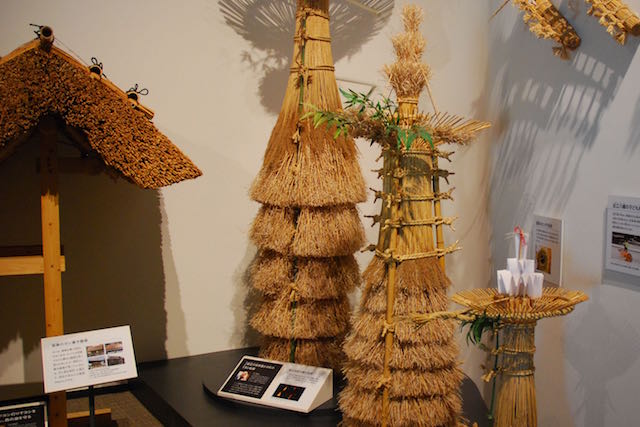
Utilization of Reeds and Reed Marches in the Past, Present and Future
Since ancient time dried reeds have been used as material for roofs, screens, and festival torches. In addition to such traditional uses, this section explores new relationships between people and the reed beds by introducing people who are developing new products using reeds and others who are conducting reed bed conservation activities. As our lifestyle changes, inexpensive reeds and reed products are imported so the use of reeds from Lake Biwa has been changing.
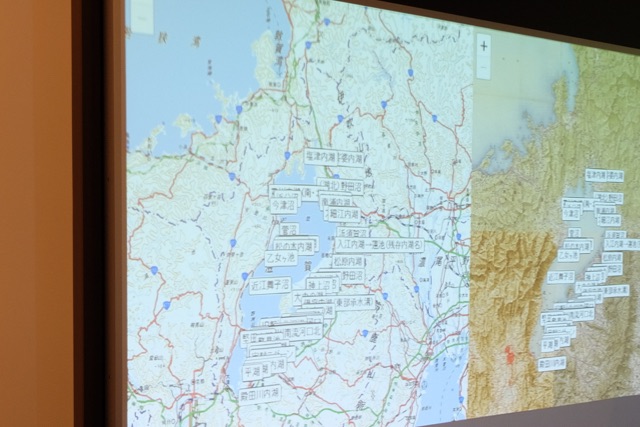
Lakeshore Wetlands and Satellite Lakes
In this section you can use the database to learn about the satellite lakes of Lake Biwa and their characteristics. This section also introduces activities underway to protect and cultivate reeds. In the past reed beds spread not only along the lake shore, but also in the satellite lakes of Lake Biwa, and they played an important role in linking the lake and people's lives. However, with reclamation works, landfill, flood control and water utilization, the outline of the lake has changed significantly and the area of reed beds has decreased.
3. To the Rice Paddies
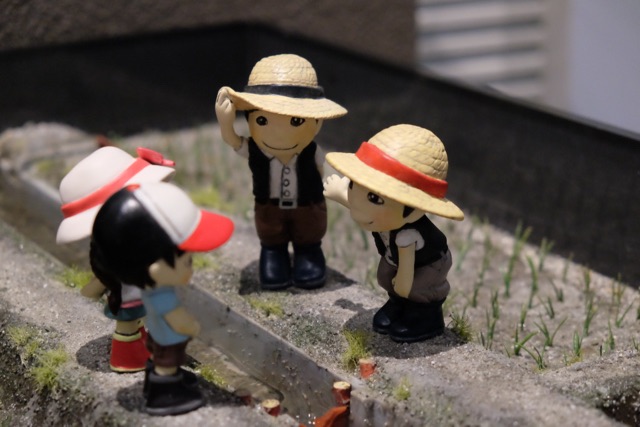
Interactions between Paddy Fields and Humans
In addition to cultivating rice, rice paddies provide a home for numerous creatures. The "To the Rice Paddies" zone examines the relationship between people and rice paddies as well as the many creatures that inhabit them. Consolidation of rice paddies around Lake Biwa occurred from about 1960 to 1980. As a result, farming became easier, but fish that used to spawn in the rice paddies could not gain access to the paddies anymore. In the 2000's, the "Fish Cradle Rice Paddies" project was launched to link rice paddies and fish.
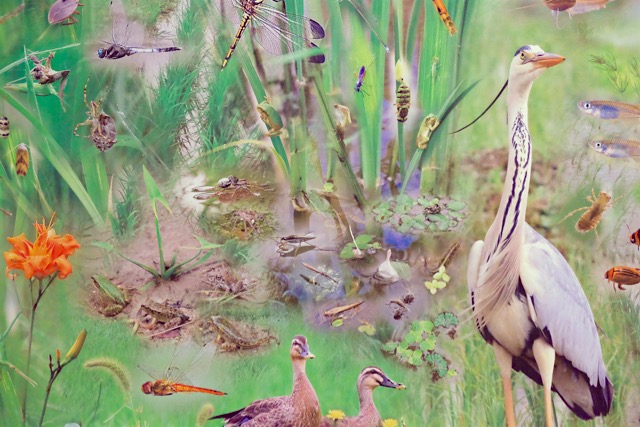
Life of Rice Paddies
More than 5,000 species inhabit the rice paddies and the surrounding areas. In this section you can see some live examples and some replicas of creatures from rice paddies. Most creatures in rice paddies are found all over Japan, but some only inhabit a particular area. For example, some ray-finned fish only inhabit Lake Biwa, and they only spawn in rice paddies around the lake. 'Hatta mimizu', the longest earthworm in Japan, can only be found in Shiga Prefecture and a few other areas.
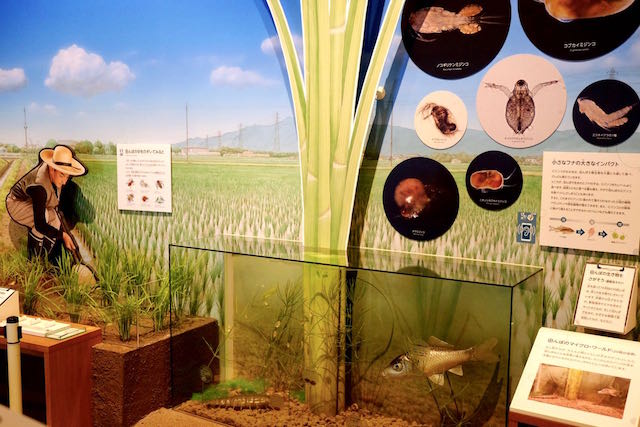
Gaze into a rice paddy
In this diorama tiny creatures that inhabit rice paddies are shown 20 times their actual size. At certain times an enormous number of water fleas can be found in rice paddies. As soon as the paddies are flooded, very small phytoplankton and protists appear in large numbers. Water fleas eat them and proliferate. Young crucian carp love eating water fleas. As the carp grow, they eat more water fleas. Finally, all water fleas are consumed and the phytoplankton and protists start to proliferate again.
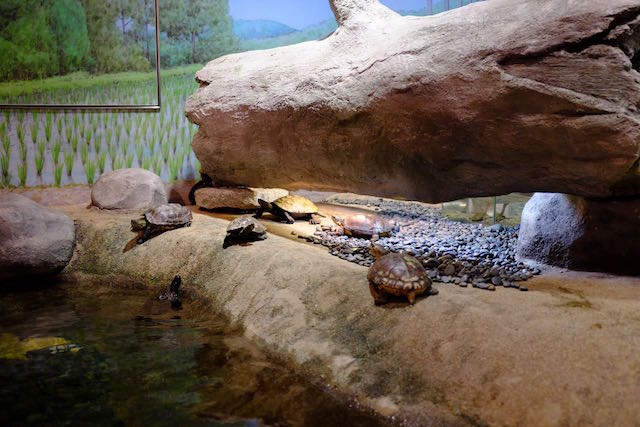
Migratory animals between rice paddies and other environments
Many creatures in rice paddies do not spend their whole lives there. This section introduces creatures, such as turtles, that travel between rice paddies and other areas including rivers and forests. The heron family builds nests among trees along the riverside and flies to rice paddies to catch and eat crayfish and insects. Many frogs that grow up in rice paddies also inhabit the forests and meadows after they move to land. For these creatures, the combination of rice paddies and other environments, such as rivers and forests, is important.
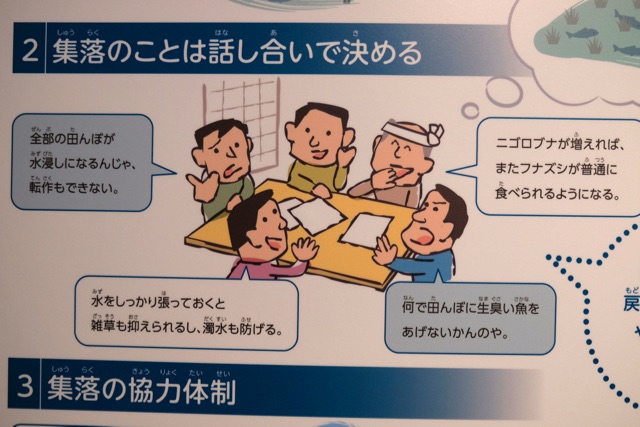
People supporting rice paddies
This section introduces various activities people are conducting to protect rice paddies and the creatures that inhabit them. Rice paddies are multifunctional, producing a number of valuable things in addition to rice. However, with each year it is becoming increasingly difficult to maintain rice paddies because the price of rice has fallen and there are not enough young people who want to farm. In order to protect the environment of rice paddies that provide various benefits to people, farming families cooperate with each other or with non-farming people and conduct various activities.
4. From Rivers to Forests
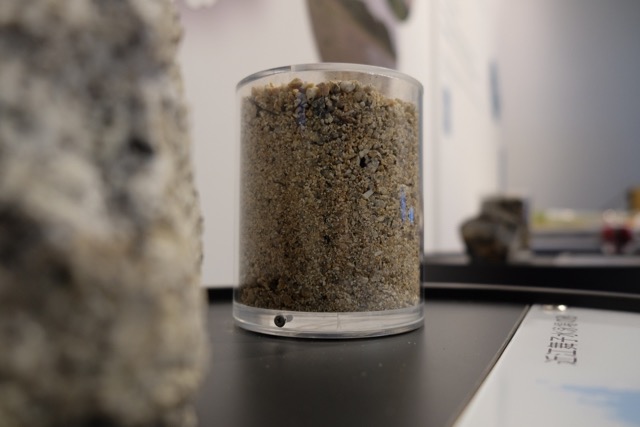
From Rivers to Forests
Did you know that the environment that is important for Lake Biwa and the creatures that inhabit it is generated by the relationship of rivers and forests? The "From Rivers to Forests" zone explains the environment of rivers and forests that is essential to Lake Biwa and the relationship between the creatures living there and people. Let's compare sand from the north, east and west shores of Lake Biwa, and rocks from the mountains, which are the source of water. The color and coarseness of the sand vary depending on the geology of the mountains from which the water comes, the length of a river and the way the water flows in a river. Sand as well as water originates in the forests and is delivered to Lake Biwa by rivers.
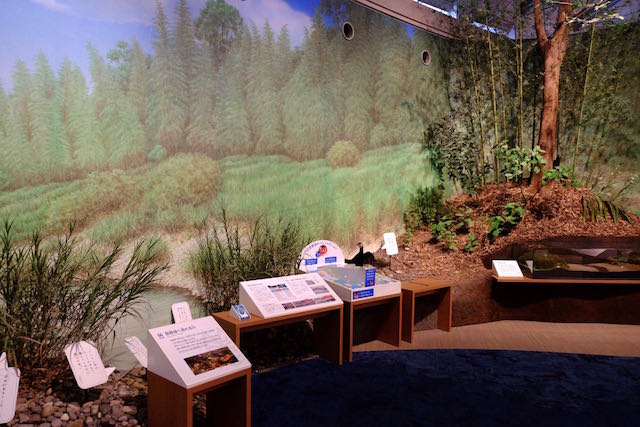
Rivers and Lake Biwa
This is a diorama of a typical river. You can see fish and birds in the river. Thanks to river work and dam construction, problems such as flooding and water shortages have been greatly reduced. However, these works block parts of the river, so fish cannot swim upstream. The fish become trapped and the herons eat them. Some sandy beaches along the lakeshore have contracted because the amount of sand delivered from the forests to the lake by rivers has been reduced. It is important to maintain the connections between the lake and the rivers that deliver water and sand.
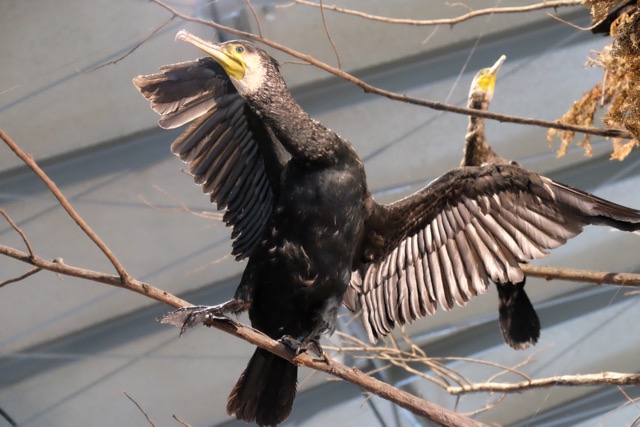
Animals linking forests, rivers, and lakes/seas
This diorama shows a forest which is the nesting ground of a flock of great cormorants, water birds that eat fish. Great cormorants are native to Japan, but because they damage valuable forests and eat sweetfish, an important resource for the local fishery, countermeasures to reduce the impact of the birds have been taken recently. Because some creatures, such as great cormorants and deer, have become too numerous in forests, the relationships among people, forest plants and creatures have become unbalanced. Please pick up a model of a great cormorant from the display table to get a sense of their size and weight, and discover how much fish they eat every day.
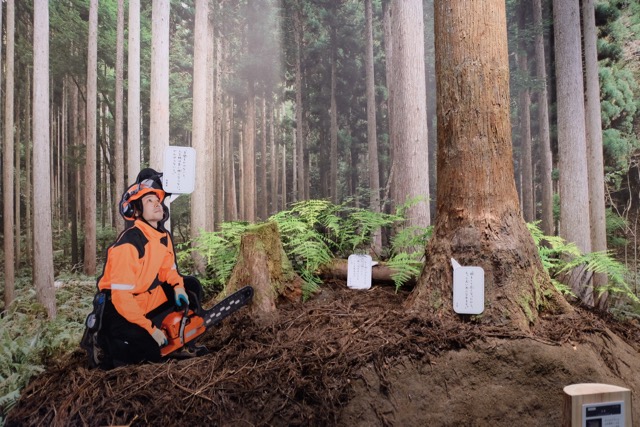
Forest plantations
These are miniature dioramas of planted forests, one that is not well-maintained and the one that is well maintained. In planted forests that are not well-maintained, trees are spindly and the forests are dark because sunlight cannot enter. Approximately 40% of the forests around Lake Biwa are planted forests. Natural forests grow naturally, but planted forests need regular maintenance to keep them healthy. It is important to cultivate planted forests that produce superior wood and protect the Lake Biwa environment through regular maintenance such as pruning and thinning.
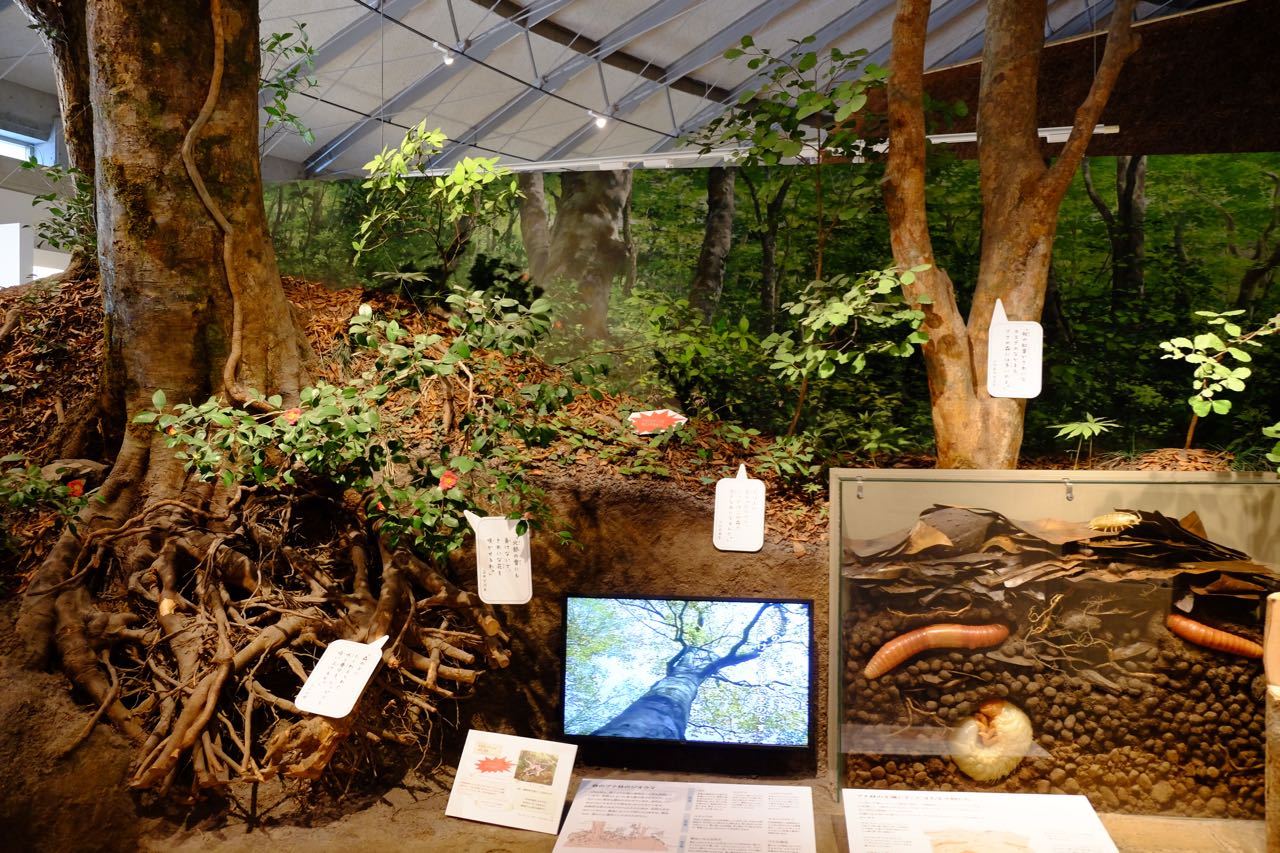
Water from Forests
This diorama shows a beech forest at a headwater from which water flows into the lake. Large beech trees extend their branches and leaves and spread their roots underground. Some of the rainwater that falls on forests is absorbed by tree roots and evaporates from leaves. Because rainwater also falls to the ground along tree trunks and is slowly absorbed into the soil, rainwater flows into the rivers little by little. In this way forests mitigate flooding.
5. Our Lifestyles
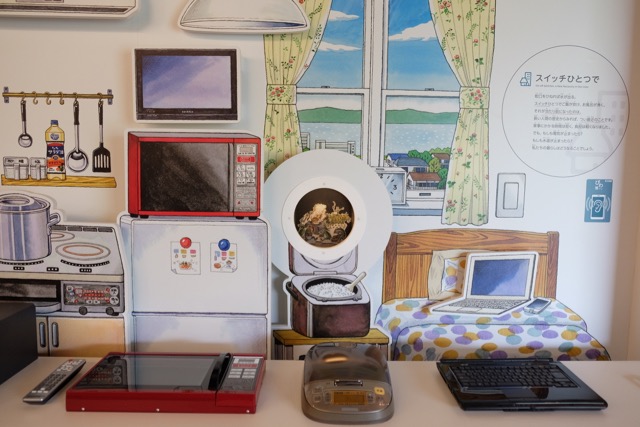
On-off Switches, a New Necessity in Our Lives
Let's have a look at the life of the people in the Lake Biwa area. The "Our Lifestyles" zone examines how dramatically life has changed in the past few decades. These are switches we use from morning to night every day. Turn on a water tap to run water. Press a switch to cook rice or heat bath water. In the context of human history these everyday conveniences have become available only very recently. Let's have a look at these switches and think about what is happening in the background.
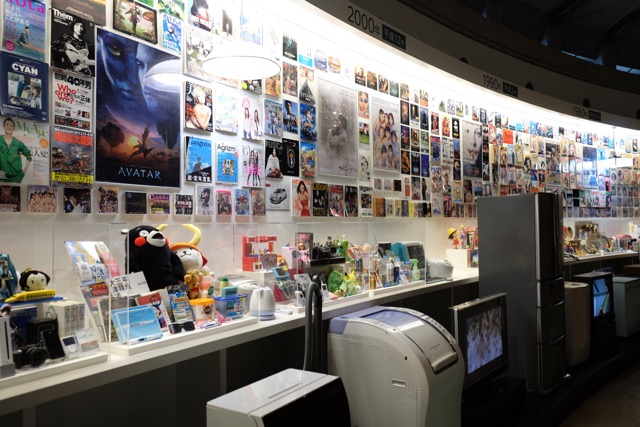
Changing Lifestyle
This exhibit displays many home appliances and other popular products that appeared between the 1960's and the present. TVs, washing machines and rice cookers … these new products have entered our lives and changed lifestyles dramatically. Since the 1990's, the development of communication technologies, such as computers, mobile phones and smartphones, has further altered our lifestyles. Through various everyday items let's examine the changes in our lifestyles.
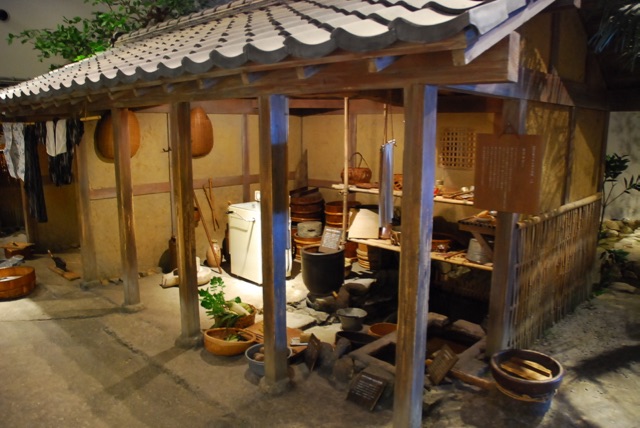
Daily Life of a Rural Family in 1964
This exhibit captures one moment at 10:00 am on May 10th, 1964, of the Tomie family who lived in Honjo-cho, Hikone City, Shiga Prefecture. Five people were living in the house - a recently married young couple, their new born baby and the baby's grandparents. No water service was available at the time. Drinking water from a flowing well was filtered for use. There was a 'kawaya', a preparation area built over a stream where dishes were washed and vegetables prepared. Rice straw was used as fuel to heat bath water and to cook food. Human waste from the toilet was a precious fertilizer to be spread on fields.
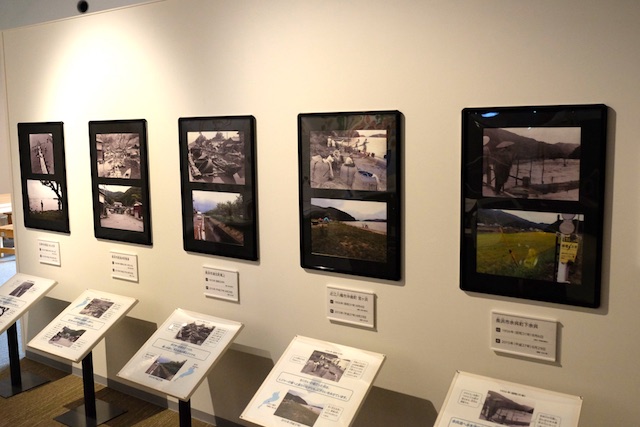
Changing Lifestyle, Changing Landscape
Old photographs from the 1950's and 1960's are displayed here along with photographs recently taken at the same places. The scenes have changed greatly. For example, the shores of Lake Biwa were once busy with people washing dishes and clothing but such a scene is a thing of the past as each household now has its own water supply. Changes in lifestyles have also changed the everyday landscape.
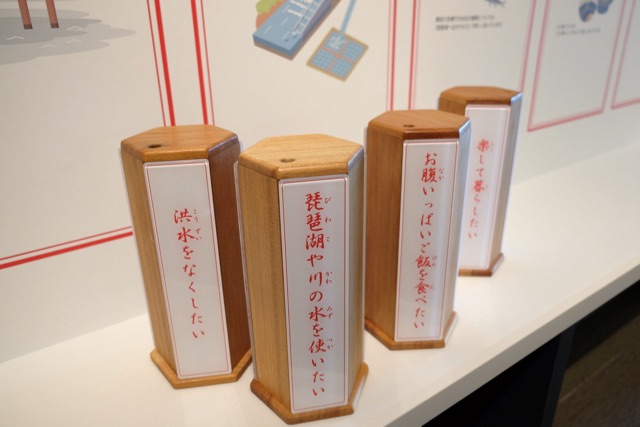
Our lifestyles and the future of local environments
Let's review our lifestyles and think about the our future lifestyles and environment. The Lake Biwa Fortune Telling corner introduces examples of the impact of changes in our lifestyle and environment. On the next monitor you can watch a video presenting messages from people who have thought about their lifestyle and the environment. The section also introduces activities for learning about the environment.
6. Lake Biwa Regional Plant and Wildlife Collection
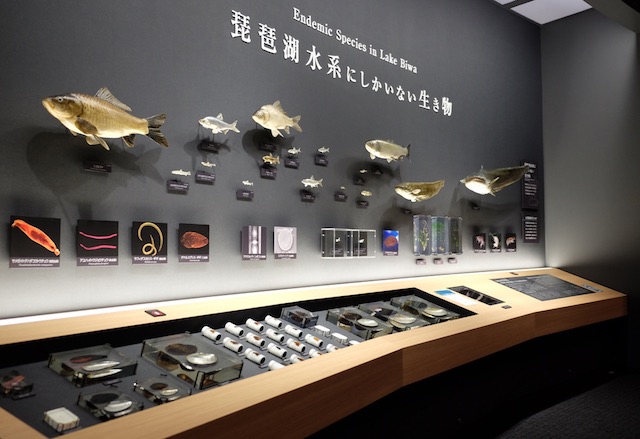
Endemic species in Lake Biwa
The "Lake Biwa Regional Plant and Wildlife Collection" section showcases the diversity and uniqueness of the creatures that inhabit Shiga Prefecture using specimens and replicas. You can see species that only inhabit the Lake Biwa water system. Species that only inhabit a specific place are called endemic. Approximately 60 endemic species, including fish and shellfish, have been found in Lake Biwa. The reason that the lake has so many endemic species is that the lake's environment is diversified and it has a four million year history. There are two kinds of endemic species - those that inhabited broader areas in ancient days but today only survive in the lake, and those that evolved in the lake.
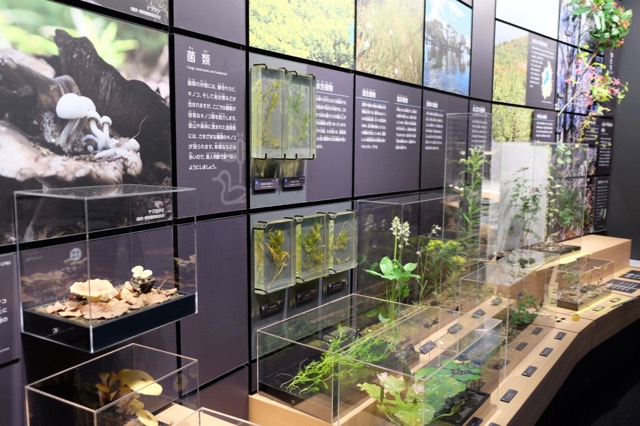
Plants and Fungi
This section displays replicas of plants and fungi from the mountains and waterside. Shiga Prefecture has a varied topography that includes mountains over 1,000 m high, lowlands, and plains. The plains include 'satoyama', which is the border zone between the foothills and arable flat land, large rivers and the Lake Biwa marshes that is utilised by people. Moreover, because the climate varies greatly between the northern and southern parts of the prefecture, approximately 2300 varieties of vegetation have been recorded. This exhibit introduces plants in the prefecture by their distributions, for example, plants from the snowy district, alpine plants from Mount Ibuki, water plants from the Lake Biwa area and lakeshore plants. The section also introduces fungi that can be found in various forests and in the 'satoyama' environments.
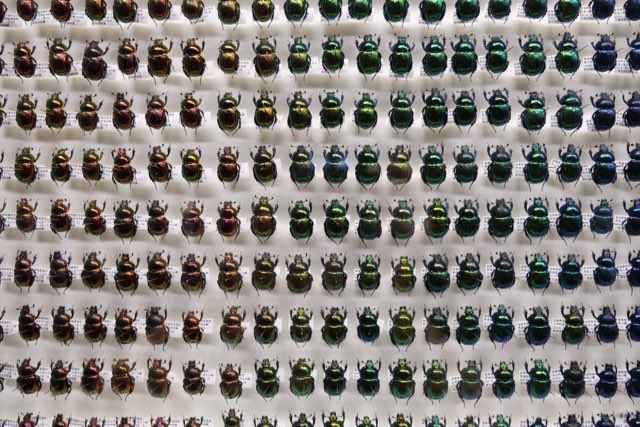
Insects
This section displays numerous specimens of insects that can be found in Shiga Prefecture. Because Shiga Prefecture has a variety of waterfront environments including Lake Biwa, the satellite lakes of Lake Biwa, large and small rivers and rice paddies, there are many native aquatic insect species. In particular, 100 dragonfly species have been observed. This is a large number compared to other prefectures and is an indication of the prefecture's varied aquatic environments. A replica of a ground beetle shows the way it eats snails by inserting its long head and thorax into the snail.
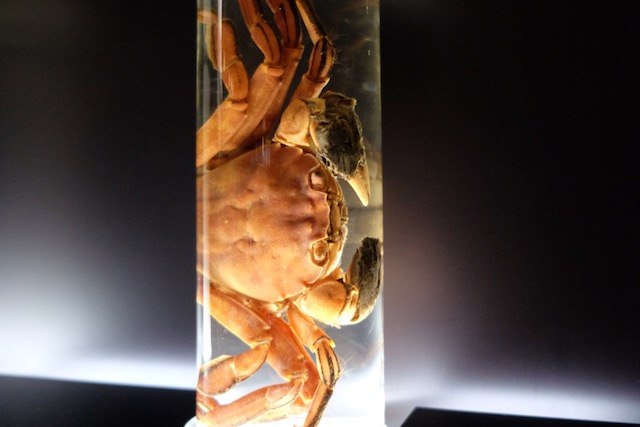
Crustaceans, parasites, and other assorted invertebrates
Approximately 700 shellfish, parasites and invertebrates have been recorded in Lake Biwa. In addition to Lake Biwa, these creatures inhabit all kinds of environments, such as plains, mountains, soils and groundwater in Shiga Prefecture. Lake shrimps are an important fishery resource in Lake Biwa.
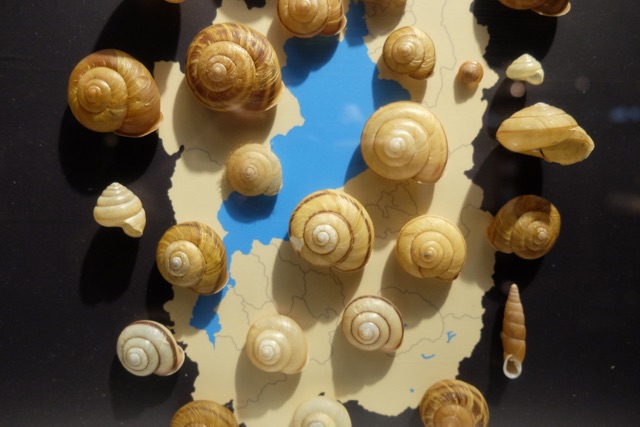
Molluscs
More than 120 types of land snails are found in Shiga Prefecture. Endemic species inhabit the limestone area between Mount Ibuki and the northern part of the Suzuka Mountains on the border of Shiga Prefecture and Gifu Prefecture. More than 60 types of freshwater shellfish are found in Shiga Prefecture. Nearly half of them are endemic species of the Lake Biwa and Yodo River system. The number of endemic molluscs is large in Lake Biwa because the lake has diversified environments and an enduring and stable aquatic environment.
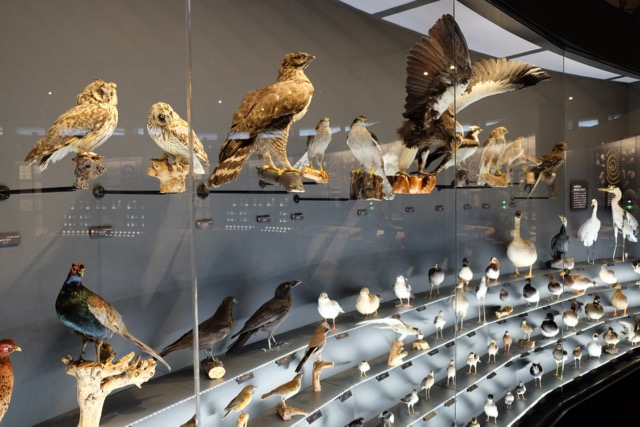
Birds
This section displays more than 100 types of bird specimens. Approximately 340 kinds of birds can be found in Shiga Prefecture throughout the year. This section displays approximately one third of these birds. Because the prefecture is located on the border of East Japan and West Japan and between the Japan Sea side and the Pacific Ocean side, a variety of migrating birds pass through the prefecture. Different birds can be found across the expanse of Lake Biwa, in the reed beds, rice paddies, thickets and in the 1,000 m high mountains of the prefecture. You can touch the wings of the specimens and observe their bodies to help understand how their unique structure can help them fly and survive.
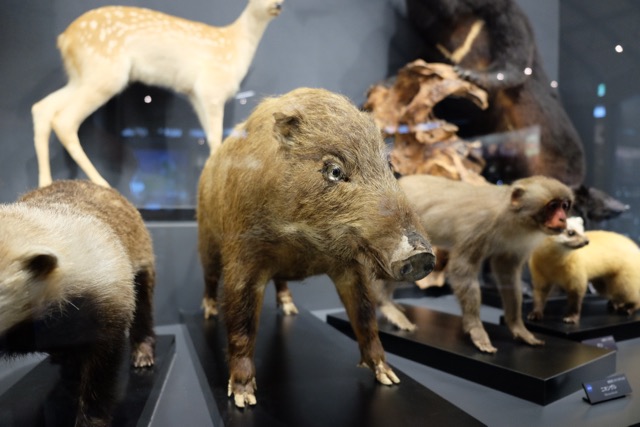
Mammals
This section displays 27 mammals, including an Asian black bear, a Japanese serow and the eight kinds of mice that inhabit Shiga Prefecture. Surprisingly, many mammals live in close proximity to people. Rivers that connect the forests and Lake Biwa also serve as paths for animals. At night raccoon dogs tread the river banks and Japanese house bats fly over rooftops.
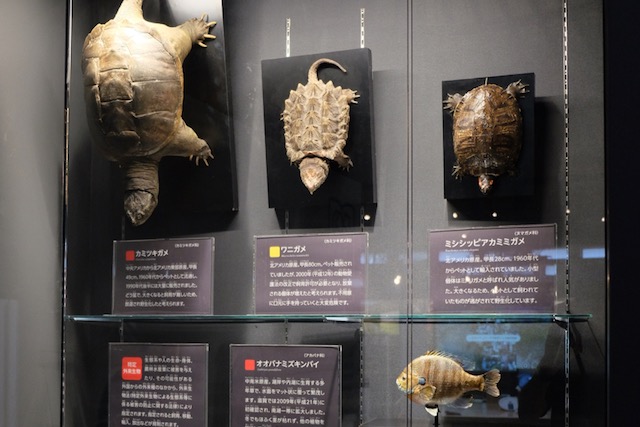
Changes in abundance and distribution of plants and animals
If the creatures living nearby are closely observed, you may notice that the number of such creatures increases or decreases. Sometimes you may find a creature that you have never seen before. This section introduces changes in the number and habitat distribution of species in Shiga Prefecture. Dandelions native to Japan are ceding habitat to varieties from foreign countries. At one time the number of great cormorants dropped significantly, but their number has grown since the 1990's. Many species are from outside the prefecture and sometimes they have a large impact on species that are native to the prefecture.
7. The Future of Lake Biwa
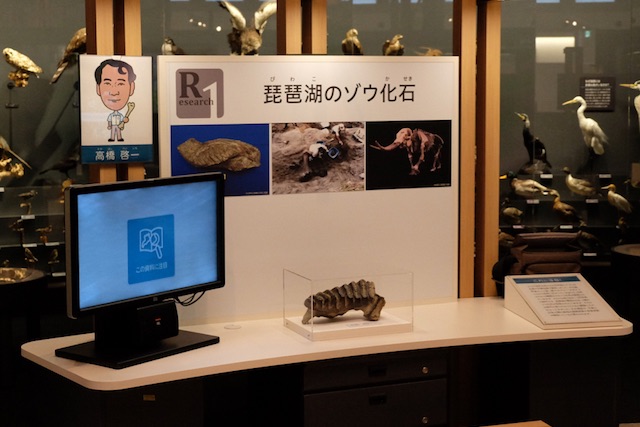
Research Stadium
There are five desks in the Research Stadium. At each desk a museum curator explains his or her research and the materials and specimens on which it is based. The curators will show videos and quiz visitors about how materials have been collected and the methods used for research. You can post a message using a computer on the desk. Every year when new exhibits are introduced, five different curators take charge of this section.
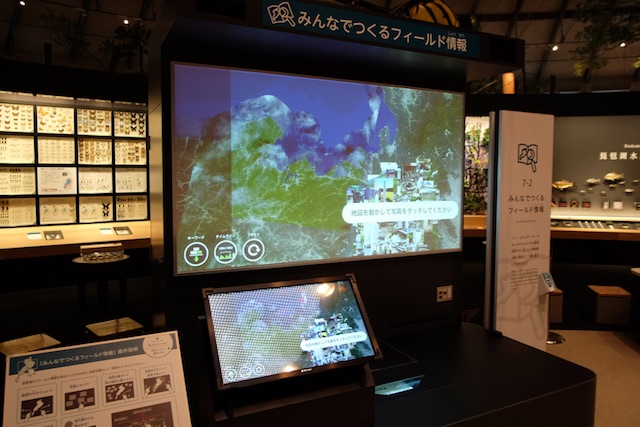
Fun Fieldwork Done by All
In this section you can see research results provided by local citizens, such as field reporters and volunteers known as 'Hashikake'. By selecting a theme, place or date of research on a touchscreen, photographs of the research and the researchers' comments are displayed. Please select your favorite theme. You can join the museum's activities and exhibit your research results with us.
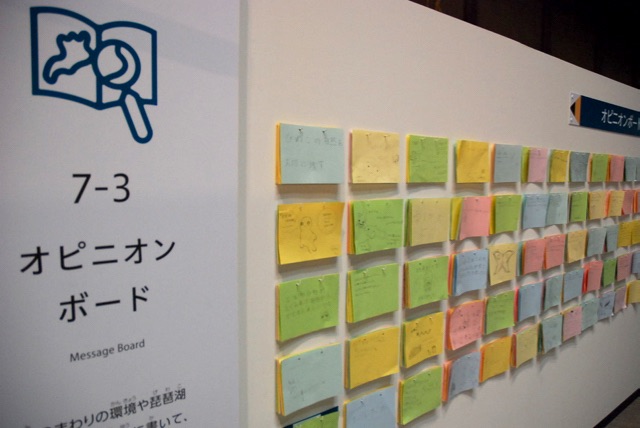
Message Board
What is an environment? What is a new co-existing relationship between the lake and people? Let's think about the future of Lake Biwa and the environment. Please write your opinions and comments about your immediate environment or Lake Biwa on a slip and place it on the Message Board in order to share your message with others.
360 Degrees Tour
Take a 360 degrees tour of Exhibition Room C. By using your mouse, or tilting your phone, you can view the exhibition room at any angle.